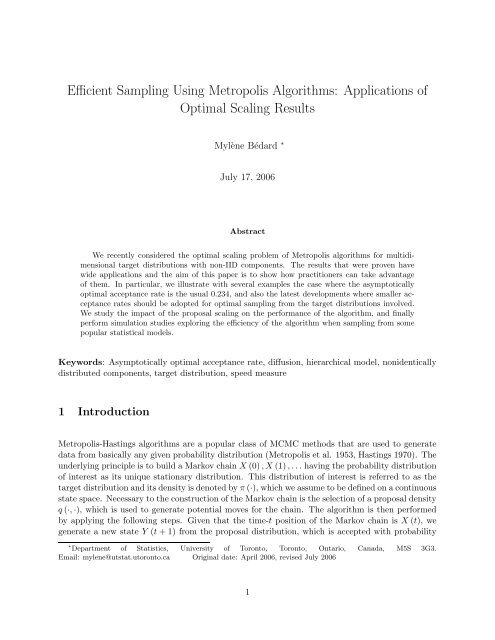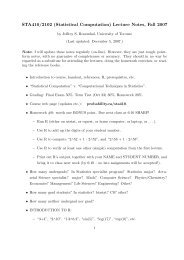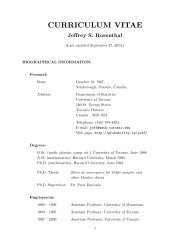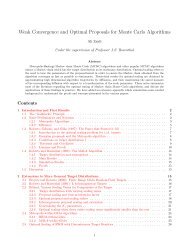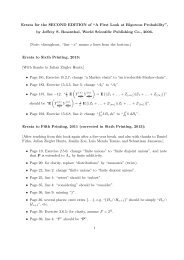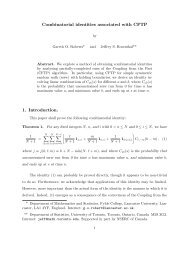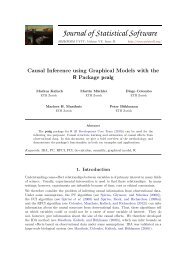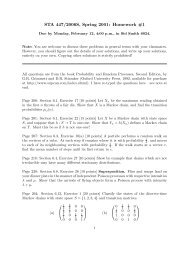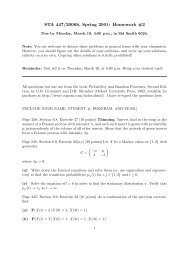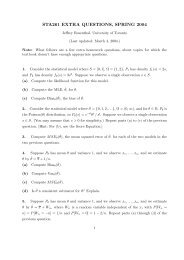Efficient Sampling Using Metropolis Algorithms ... - probability.ca
Efficient Sampling Using Metropolis Algorithms ... - probability.ca
Efficient Sampling Using Metropolis Algorithms ... - probability.ca
Create successful ePaper yourself
Turn your PDF publications into a flip-book with our unique Google optimized e-Paper software.
<strong>Efficient</strong> <strong>Sampling</strong> <strong>Using</strong> <strong>Metropolis</strong> <strong>Algorithms</strong>: Appli<strong>ca</strong>tions of<br />
Optimal S<strong>ca</strong>ling Results<br />
Mylène Bédard ∗<br />
July 17, 2006<br />
Abstract<br />
We recently considered the optimal s<strong>ca</strong>ling problem of <strong>Metropolis</strong> algorithms for multidimensional<br />
target distributions with non-IID components. The results that were proven have<br />
wide appli<strong>ca</strong>tions and the aim of this paper is to show how practitioners <strong>ca</strong>n take advantage<br />
of them. In particular, we illustrate with several examples the <strong>ca</strong>se where the asymptoti<strong>ca</strong>lly<br />
optimal acceptance rate is the usual 0.234, and also the latest developments where smaller acceptance<br />
rates should be adopted for optimal sampling from the target distributions involved.<br />
We study the impact of the proposal s<strong>ca</strong>ling on the performance of the algorithm, and finally<br />
perform simulation studies exploring the efficiency of the algorithm when sampling from some<br />
popular statisti<strong>ca</strong>l models.<br />
Keywords: Asymptoti<strong>ca</strong>lly optimal acceptance rate, diffusion, hierarchi<strong>ca</strong>l model, nonidenti<strong>ca</strong>lly<br />
distributed components, target distribution, speed measure<br />
1 Introduction<br />
<strong>Metropolis</strong>-Hastings algorithms are a popular class of MCMC methods that are used to generate<br />
data from basi<strong>ca</strong>lly any given <strong>probability</strong> distribution (<strong>Metropolis</strong> et al. 1953, Hastings 1970). The<br />
underlying principle is to build a Markov chain X (0) , X (1) , . . . having the <strong>probability</strong> distribution<br />
of interest as its unique stationary distribution. This distribution of interest is referred to as the<br />
target distribution and its density is denoted by π (·), which we assume to be defined on a continuous<br />
state space. Necessary to the construction of the Markov chain is the selection of a proposal density<br />
q (·, ·), which is used to generate potential moves for the chain. The algorithm is then performed<br />
by applying the following steps. Given that the time-t position of the Markov chain is X (t), we<br />
generate a new state Y (t + 1) from the proposal distribution, which is accepted with <strong>probability</strong><br />
∗ Department of Statistics, University of Toronto, Toronto, Ontario, Canada, M5S 3G3.<br />
Email: mylene@utstat.utoronto.<strong>ca</strong> Original date: April 2006, revised July 2006<br />
1
α (X (t) , Y (t + 1)), where α (x, y) = 1 ∧ (π (y) q (y, x) /π (x) q (x, y)). If the suggested move is<br />
accepted, then the chain moves from X (t) to Y (t + 1); otherwise, X (t + 1) = X (t).<br />
The acceptance <strong>probability</strong> α (x, y) is chosen such that the Markov chain is reversible with respect<br />
to the target density π (·), ensuring that π (·) is stationary for the chain. To compel the convergence<br />
of the Markov chain to its stationary distribution, one might choose virtually any proposal density<br />
engendering a Markov chain that is irreducible and aperiodic. A popular choice for the proposal<br />
distribution is the normal family centered at the current state X (t) and s<strong>ca</strong>led according to σ 2 .<br />
For an algorithm with such a proposal distribution to be efficient, one must however <strong>ca</strong>refully select<br />
the variance term. Indeed, small values for σ 2 <strong>ca</strong>use the chain to jump to nearby states, resulting<br />
in a lengthy exploration of the state space. On the other hand, large s<strong>ca</strong>ling values often suggest<br />
states lo<strong>ca</strong>ted in low target density regions, encouraging the chain to refuse these moves and stand<br />
still for long periods of time.<br />
In this paper, we consider the optimal s<strong>ca</strong>ling problem of <strong>Metropolis</strong> algorithms (Roberts et al.<br />
1997, Breyers & Roberts 2000, Roberts & Rosenthal 2001, Neal & Roberts 2004) for targets with<br />
independent but not identi<strong>ca</strong>lly distributed components, and study how well existing asymptotic<br />
results serve the practi<strong>ca</strong>l side. In particular, we consider the target model introduced recently in<br />
Bédard (2006a,b) and present various examples illustrating how the optimal value for the proposal<br />
variance and acceptance rate <strong>ca</strong>n be determined using the theorems proved in these papers. This<br />
demonstrates that, although of asymptotic nature, the results <strong>ca</strong>n be used to facilitate the tuning<br />
of algorithms in finite-dimensional problems.<br />
In Section 2 we shall introduce the target and proposal distributions considered, and briefly discuss<br />
measures of efficiency for the algorithm. The optimal s<strong>ca</strong>ling results that shall be presented in<br />
Section 3 are divided in three <strong>ca</strong>ses: the asymptoti<strong>ca</strong>lly optimal acceptance rate (AOAR) is the<br />
usual 0.234; the AOAR is smaller than 0.234 and its exact value is solved on a <strong>ca</strong>se per <strong>ca</strong>se basis;<br />
finally the AOAR is 0, in which <strong>ca</strong>se the efficiency of the algorithm <strong>ca</strong>nnot be optimized. In that<br />
occurrence, we must then resort to inhomogeneous proposal distributions. In each of the three<br />
parts, the theoreti<strong>ca</strong>l results are first discussed and examples illustrating their appli<strong>ca</strong>tion are then<br />
presented. Section 4 aims to present simulation studies to investigate the efficiency of the algorithm<br />
applied to more compli<strong>ca</strong>ted and widely used statisti<strong>ca</strong>l models; specifi<strong>ca</strong>lly, we consider the normal<br />
hierarchi<strong>ca</strong>l model, the variance components model and the gamma-gamma hierarchi<strong>ca</strong>l model.<br />
2 The Model<br />
To illustrate the purpose of the following sections, suppose we wish to sample from<br />
π (x 1 , . . . , x d ) ∝ x 4 1 exp (−x 1 ) x 4 2 exp (−x 2 )<br />
d∏<br />
i=3<br />
(<br />
x 4 i exp −x i /5 √ )<br />
d . (1)<br />
For a relatively low-dimensional target density of this sort, say d = 10, the density of the last<br />
8 components is spread out over (0, ∞) while that of the first two have their mass concentrated<br />
within a much narrower interval of the state space. Choosing a proper variance for the proposal<br />
distribution is thus not an easy task: the last 8 components require a large proposal variance for<br />
appropriate exploration of their state space, but the selection of too large a value would result in<br />
2
frequent rejection of the proposed moves by the variables X 1 and X 2 . A compromise between these<br />
requirements then becomes necessary.<br />
For this example, the optimal proposal variance is close to σ 2 = 61 for any dimension d, resulting in<br />
an AOAR lying around 0.098, as shall be seen in Example 5. In fact, tuning the algorithm to accept<br />
a proportion of 23.4% of the proposed moves would reduce the efficiency of the algorithm by about<br />
20%, from where the importance of determining the right proposal variance. Before discussing the<br />
optimal s<strong>ca</strong>ling results, we however start by introducing the general model for the target density.<br />
2.1 The Target Distribution<br />
Suppose we want to generate a sample from the d-dimensional target density<br />
(<br />
π d, x (d)) =<br />
d∏<br />
θ j (d) f (θ j (d) x j ) , (2)<br />
j=1<br />
where f is a smooth density and θj<br />
−2 (d), j = 1, . . . , d are referred to as the s<strong>ca</strong>ling terms of the<br />
target distribution, which <strong>ca</strong>n be any function of d for which the limit exists. This model constitutes<br />
a natural extension of the d-dimensional density formed of independent and identi<strong>ca</strong>lly distributed<br />
(IID) components considered in the literature and used to investigate optimal acceptance rates.<br />
The optimal s<strong>ca</strong>ling results that shall be presented for sampling from this target are originally<br />
valid for infinite-dimensional distributions. As d increases, some of the s<strong>ca</strong>ling terms will thus be<br />
repeated an infinite number of times; we assume that there are 0 < m < ∞ such different terms.<br />
Other terms will not be repli<strong>ca</strong>ted as d → ∞; we suppose that there are n < ∞ of them. We let the<br />
first n + m components of the vector Θ −2 (d) consist in the n non-repli<strong>ca</strong>ted s<strong>ca</strong>ling terms, followed<br />
by the m different s<strong>ca</strong>ling terms that shall be repli<strong>ca</strong>ted. We further assume that the first n and<br />
next m components are respectively arranged according to an asymptoti<strong>ca</strong>lly increasing order.<br />
Although the components θ n+1 (d) , · · · , θ n+m (d) appear infinitely often as d → ∞, they might<br />
however not be repli<strong>ca</strong>ted the same number of times. To determine the proportion of Θ −2 (d)<br />
occupied by the i-th group (i ∈ {1, . . . , m}), we define the <strong>ca</strong>rdinality functions<br />
c (i, d) = # {j ∈ {1, . . . , d} ; θ j (d) = θ n+i (d)} , i = 1, . . . , m. (3)<br />
The following example should help clarifying the notation just introduced.<br />
Example 1. Consider a d-dimensional target density as in (2) with s<strong>ca</strong>ling terms 1/ √ d, 4/ √ d, 10<br />
and the other ones equally divided among 2 √ d(<br />
and (d + 1) /2. As d → ∞, the last two s<strong>ca</strong>ling terms<br />
are repli<strong>ca</strong>ted so n = 3, m = 2 and Θ −2 (d) = 1/ √ d, 4/ √ d, 10, 2 √ d, (d + 1) /2, 2 √ )<br />
d, (d + 1) /2, . . . .<br />
The <strong>ca</strong>rdinality functions for the s<strong>ca</strong>ling terms appearing infinitely often in the limit are<br />
{<br />
(<br />
c (1, d) = # j ∈ {1, . . . , d} ; θ j (d) = 2 √ ) } ⌈ ⌉<br />
−1/2 d − 3<br />
d =<br />
2<br />
and c (2, d) = ⌊(d − 3) /2⌋, where ⌈·⌉ and ⌊·⌋ denote the ceiling and integer part functions respectively.<br />
Note however that such rigorousness is superfluous for applying the results and it is enough<br />
to affirm that both <strong>ca</strong>rdinality functions grow according to d/2.<br />
3
For simplicity’s sake, the model just presented for the target is not the most general form under<br />
which the conclusions of the theorems are satisfied. Indeed, it would be sufficient to assume that<br />
s<strong>ca</strong>ling terms belonging to a common group i ∈ {1, . . . , m} are of the same order. For more details,<br />
we refer the reader to Bédard (2006a,b).<br />
2.2 The Proposal Distribution and its S<strong>ca</strong>ling<br />
The proposal distribution we consider ) for sampling from the target density π (·) is such that<br />
Y (d) (t + 1) ∼ N<br />
(X (d) (t) , σ 2 (d) I d , where I d is the d-dimensional identity matrix.<br />
There exist two factors determining the form of the proposal variance as a function of d: the<br />
asymptoti<strong>ca</strong>lly smallest s<strong>ca</strong>ling term and the fact that some s<strong>ca</strong>ling terms appear infinitely often in<br />
the limit. If the first factor were ignored, the proposed moves would possibly be too large for the<br />
corresponding component, resulting in high rejection rates and slow convergence of the algorithm.<br />
The effect of the second factor is that as d → ∞, the algorithm proposes more independent moves<br />
in a single step, increasing the odds of proposing an improbable move. In this <strong>ca</strong>se, a drop in<br />
the acceptance rate <strong>ca</strong>n be overturned by letting σ 2 (d) be a decreasing function of the dimension.<br />
Combining these two constraints, the optimal form for the proposal variance as a function of d<br />
<strong>ca</strong>n be shown to be σ 2 (d) = l 2 σα 2 (d), with l some positive constant and σα 2 (d) the largest order<br />
function such that<br />
lim<br />
d→∞ θ2 1 (d) σα 2 (d) < ∞ and<br />
lim c (i, d) θn+i 2 (d) σα 2 (d) < ∞ for i = 1, . . . , m. (4)<br />
d→∞<br />
Our goal has thus evolved in optimizing the choice of the constant l in σ 2 (d).<br />
Example 2. We now determine the optimal form for the proposal variance of the <strong>Metropolis</strong><br />
algorithm in Example 1. According to (4), we have three limits to verify: the first one involves<br />
θ1 −2 (d), which is also the asymptoti<strong>ca</strong>lly smallest √ s<strong>ca</strong>ling term in the present <strong>ca</strong>se; the largest σα 2 (d)<br />
satisfying the finite property for lim d→∞ dσ<br />
2<br />
α (d) is 1/ √ d. For the second and third limits, we<br />
have lim d→∞ (d − 3) σα 2 (d) /4 √ d and lim d→∞ (d − 3) σα 2 (d) / (d + 1); the largest σα 2 (d) satisfying<br />
the finite property is then 1/ √ d and 1 respectively. The function of largest order satisfying the<br />
constraint that all three limits be finite is σα 2 (d) = 1/ √ d.<br />
2.3 Efficiency of the Algorithm<br />
In order to optimize the mixing of our <strong>Metropolis</strong> algorithm, it would be convenient to determine<br />
criteria for measuring efficiency. The natural way to estimate a function of interest g (·) is to compute<br />
the expectation of g (·) with respect to π (·). Minimizing the asymptotic variance of g (·) would<br />
then be a good way to optimize efficiency; however, an important drawback of this measure consists<br />
in its dependence on g (·). Since we do not want to lose generality by specifying such a quantity<br />
of interest, we instead choose the first order efficiency criterion, as used by Roberts & Rosenthal<br />
(1998) and Pasari<strong>ca</strong> & Gelman (2003). This measures the average squared [ jumping distance of the<br />
(<br />
(n + 1)-st component of the algorithm and is defined by F OE = E X (d)<br />
) 2<br />
n+1 (t + 1) − X(d) n+1<br />
]. (t)<br />
4
The fact that F OE is based on the path of the (n + 1)-st component of the Markov chain is an<br />
important detail, given that the d components are not all identi<strong>ca</strong>lly distributed (although we could<br />
have chosen any of the last d − n components). Indeed, as d → ∞, it <strong>ca</strong>n be shown that the path<br />
followed by any of the last d − n components of an appropriately res<strong>ca</strong>led version of the <strong>Metropolis</strong><br />
algorithm converges to a diffusion process with speed measure υ (l). For any function of interest<br />
g (·), optimal efficiency is thus obtained by maximizing the speed measure, meaning that the effect<br />
of choosing a particular efficiency criterion vanishes as d gets larger. Consequently, the optimization<br />
problem is the same no matter which function g (·) is under investigation and any efficiency measure<br />
considered in finite dimensions will be asymptoti<strong>ca</strong>lly equivalent (i.e. as d → ∞), including the<br />
first order efficiency introduced previously.<br />
Even though the last d − n terms always converge to some diffusion limit, it might not be the <strong>ca</strong>se<br />
for the first n components, whose limit could remain discrete as d → ∞. Trying to optimize the<br />
proposal variance by relying on these components would then result in conclusions that are specific<br />
to our choice of efficiency measure.<br />
3 Optimal S<strong>ca</strong>ling Results<br />
3.1 The Familiar Asymptotic Behavior<br />
Consider a <strong>Metropolis</strong> algorithm with proposal distribution Y (d) ∼ N<br />
(x (d) , l 2 σ 2 α (d) I d<br />
)<br />
, where<br />
σ 2 α (d) satisfies (4). Suppose this algorithm is used to sample from a target density as in (2) and<br />
supporting the model described in Section 2.1.<br />
It is now an established fact that 0.234 is the AOAR for target distributions with IID components<br />
(Roberts et al. 1997). Roberts & Rosenthal (2001) also showed that the same conclusion applies for<br />
π (·) as in (2) but with θ j (d)’s independent of d. It is thus natural to wonder how big a discrepancy<br />
between the s<strong>ca</strong>ling terms is tolerated in order not to violate this established asymptotic behavior.<br />
It turns out that if<br />
lim<br />
d→∞<br />
θ1 2 ∑ (d)<br />
dj=1<br />
θj 2 = 0, (5)<br />
(d)<br />
then the optimal acceptance rate <strong>ca</strong>n be shown to converge towards 0.234. The optimal value ˆl<br />
maximizes the equation<br />
(<br />
υ (l) = 2l 2 Φ − l√ )<br />
E R<br />
= l 2 a (l) , (6)<br />
2<br />
where a (l) = 2Φ ( −l √ E R /2 ) is the asymptotic acceptance rate of the algorithm and<br />
[<br />
m∑<br />
(f<br />
E R = lim c (i, d) θn+i 2 (d) σα 2 ′ )<br />
(X) 2<br />
]<br />
(d) E<br />
, (7)<br />
d→∞<br />
f (X)<br />
i=1<br />
with c (i, d) as in (3). We then obtain ˆl = 2.38/ √ E R , from where a(ˆl) = 0.234. For a formal version<br />
of the theorem, see Bédard (2006a).<br />
5
This result provides valuable guidelines for practitioners. It reveals that when the target distribution<br />
has no s<strong>ca</strong>ling term that is signifi<strong>ca</strong>ntly smaller than the others, the asymptotic acceptance rate<br />
optimizing the efficiency of the chain is 0.234. Alternatively, setting l equal to 2.38/ √ E R leads<br />
to greatest efficiency of the algorithm. In some situations, finding ˆl will be easier while in others,<br />
tuning the algorithm according to the AOAR will reveal more convenient. In the present <strong>ca</strong>se,<br />
since the AOAR does not depend on the target density, it is simpler in practice to monitor the<br />
acceptance rate and to tune it to be about 0.234.<br />
While the AOAR is independent of the target distribution, ˆl varies inversely proportionally to<br />
E R . Two different factors influence this quantity: the function f (·) in (2) and the θj<br />
−2 (d)’s. The<br />
latter <strong>ca</strong>n have an effect through their size or the proportion of the vector Θ −2 (d) they occupy.<br />
Specifi<strong>ca</strong>lly, suppose that c (i, d) θn+i 2 (d) is O ( σα<br />
−2 (d) ) for some i ∈ {1, . . . , m}, implying that the<br />
i-th group contributes to augment the value of E R . The amount by which E R increases is then<br />
proportional to the size of the θ j (d)’s, but inversely proportional to the quantity of s<strong>ca</strong>ling terms<br />
included in the group. The following examples shall clarify these concepts.<br />
Example 3. Consider a d-dimensional target with independent, normally distributed components;<br />
we suppose that half of them have a variance of 1 and the other half a variance of 2d. Applying<br />
(4), the proposal variance takes the form σ 2 (d) = l 2 /d and Condition (5) is verified by computing<br />
lim d→∞ (d/2 + 1/4) −1 = 0 (in fact this is trivial since n = 0). We <strong>ca</strong>n thus optimize the efficiency<br />
of the algorithm by setting the acceptance rate to be close to 0.234; equivalently, since E R =<br />
lim d→∞ (1/2 + 1/4d) = 1/2, we find ˆl = 3.366. What is <strong>ca</strong>using an increase of ˆl with respect to<br />
the baseline 2.38 for the <strong>ca</strong>se where all components are IID standard normal is the fact that only<br />
half of the components affect the accept/reject ratio in the limit.<br />
The left graph in Figure 1 presents the relation between first order efficiency and l 2 . The dotted<br />
curve has been obtained by performing 100,000 iterations of the <strong>Metropolis</strong> algorithm with d = 100,<br />
and as expected the maximum is lo<strong>ca</strong>ted very close to ˆl 2 = 11.33. The simulations also agree with<br />
the theoreti<strong>ca</strong>l curve (solid line) of υ (l) in (6) versus l 2 . For the second graph, we run the algorithm<br />
with various values of l and plot F OE as a function of the proportion of accepted moves for the<br />
different proposal variances. That is, each point in a given curve is the result of a simulation<br />
with a particular value for l. We again performed 100,000 iterations, but this time we repeated<br />
the simulations for different dimensions (d = 10, 20, 50, 100), outlining the fact that the optimal<br />
acceptance rate converges very rapidly to its asymptotic counterpart. The theoreti<strong>ca</strong>l curve of υ (l)<br />
versus a (l) is represented by the solid line.<br />
We note that efficiency is a relative measure in our <strong>ca</strong>se. Consequently, choosing an acceptance<br />
rate around 0.05 or 0.5, would necessitate to run the chain 1.5 times as long to obtain the same<br />
precision for a particular estimate.<br />
Although MCMC methods are not necessarily required to sample from normal distributions, this<br />
type of target is widely used in the literature to investigate the optimal s<strong>ca</strong>ling problem, and thus<br />
allows us to see how our results compare to others. Note however that we could also have used any<br />
smooth density f (·) with any Θ −2 (d) satisfying Condition (5). While the convergence might get<br />
slightly slower as f (·) gets further from normality, we generally observe curves similar to those of<br />
Figure 1, as well as a rapid convergence to the asymptotic curve. The following example presents<br />
a particular situation where the convergence of some components towards the AOAR is extremely<br />
slow, a phenomenon due to the form of Θ −2 (d).<br />
6
+++<br />
Efficiency<br />
0.5 1.0 1.5 2.0 2.5<br />
Efficiency<br />
0.5 1.0 1.5 2.0 2.5<br />
*<br />
**<br />
*<br />
*<br />
**<br />
*<br />
*<br />
+<br />
++<br />
+<br />
+<br />
**<br />
*<br />
*<br />
* *<br />
*<br />
+ +++<br />
+<br />
* ** *<br />
+<br />
++<br />
++<br />
*<br />
*<br />
++<br />
+<br />
**<br />
*<br />
+<br />
+<br />
*<br />
*<br />
*<br />
+ +<br />
+ +<br />
*<br />
+<br />
*<br />
+<br />
*<br />
+<br />
*<br />
*<br />
+ +<br />
*<br />
+<br />
+<br />
*<br />
+<br />
*<br />
+<br />
*<br />
+<br />
*<br />
+<br />
*<br />
+<br />
*<br />
+<br />
*<br />
+<br />
*<br />
+<br />
*<br />
+<br />
*<br />
+<br />
*<br />
+<br />
d = 100<br />
d = 50<br />
d = 20<br />
d = 10<br />
+ *<br />
+ *<br />
0 5 10 15 20 25 30<br />
S<strong>ca</strong>ling Parameter<br />
0.2 0.4 0.6 0.8<br />
Acceptance rate<br />
Figure 1: Left graph: efficiency of X 1 versus l 2 ; the dotted line is the result of simulations with<br />
d = 100. Right graph: efficiency of X 1 versus the acceptance rate; the dotted lines come from<br />
simulations in dimensions 10, 20, 50 and 100. In both graphs, the solid line represents the theoreti<strong>ca</strong>l<br />
curve υ (l).<br />
Example 4. Consider a multivariate normal target with independent components and variances<br />
Θ −2 (d) = ( d −0.75 , 1, 1, 1, . . . ) . We find σ 2 (d) = l 2 /d and lim d→∞ d 0.75 ( d 0.75 + (d − 1) ) −1 = 0,<br />
implying that Condition (5) is verified. The quantity E R being equal to 1, the optimal value for l<br />
is then the baseline 2.38.<br />
The particularity of this <strong>ca</strong>se resides in the size of θ −2<br />
1 (d), which is somewhat smaller than the<br />
other terms but not enough to remain signifi<strong>ca</strong>nt as d → ∞. As a consequence, the dimension of<br />
the target distribution must be quite large before the asymptotics kick in. In small dimensions,<br />
the optimal acceptance rate is thus closer to the <strong>ca</strong>se where there exist signifi<strong>ca</strong>ntly small s<strong>ca</strong>ling<br />
terms, which shall be studied in Section 3.2.<br />
Figure 2 demonstrates that even in small dimensions, the first order efficiency criterion based on<br />
any of the last d−1 components is very close to 0.234 so as not to make much difference in practice.<br />
When first order efficiency is based on X 1 however, setting d = 100 yields an optimal acceptance<br />
rate around 0.3 and the dimensions must be raised as high as 100,000 to get an optimal acceptance<br />
rate reasonably close to the asymptotic one. Relying on X 1 would then falsely suggest a higher<br />
optimal acceptance rate, as explained in Section 2.3.<br />
3.2 A Reduction of the Asymptoti<strong>ca</strong>lly Optimal Acceptance Rate<br />
In the presence of a finite number of signifi<strong>ca</strong>ntly small s<strong>ca</strong>ling terms, choosing a correct proposal<br />
variance is a slightly more deli<strong>ca</strong>te task. We <strong>ca</strong>n think for instance of the density in (1), which<br />
seems to promote contradictory characteristics when it comes to the selection of an efficient proposal<br />
variance. In that example, the components X 1 and X 2 are said to rule the algorithm since they<br />
ensure that the proposal variance is not too big as a function of d. When dealing with such target<br />
7
+++<br />
Efficiency<br />
0.2 0.4 0.6 0.8 1.0 1.2<br />
**<br />
**<br />
**<br />
*<br />
*<br />
** + ++<br />
+<br />
+<br />
*<br />
**<br />
***<br />
++<br />
+<br />
* ***<br />
* * *<br />
*<br />
*<br />
+ + ++ +++<br />
++ +<br />
*<br />
*<br />
++<br />
*<br />
*<br />
*<br />
++ +<br />
*<br />
*<br />
++<br />
*<br />
+<br />
*<br />
+<br />
*<br />
+<br />
*<br />
+<br />
*<br />
+<br />
*<br />
+<br />
*<br />
+<br />
*<br />
+<br />
*<br />
+<br />
+<br />
*<br />
+<br />
*<br />
*<br />
+<br />
*<br />
+<br />
*<br />
+<br />
d = 200,000<br />
d = 100,000<br />
d = 100<br />
d = 10<br />
*<br />
+<br />
*<br />
+<br />
+ *<br />
+ *<br />
Efficiency<br />
0.2 0.4 0.6 0.8 1.0 1.2<br />
d = 200,000<br />
d = 100<br />
0.2 0.4 0.6 0.8<br />
Acceptance Rate<br />
0.2 0.4 0.6 0.8<br />
Acceptance Rate<br />
Figure 2: Left graph: efficiency of X 1 versus the acceptance rate; the dotted curves are the results<br />
of simulations in dimensions 10, 100, 100,000 and 200,000. Right graph: efficiency of X 2 versus the<br />
acceptance rate; the dotted curves come from simulations in dimensions 100 and 200,000. In both<br />
graphs, the solid line represents the theoreti<strong>ca</strong>l curve υ (l).<br />
densities, we realize that Condition (5) is violated, and thus<br />
lim<br />
d→∞<br />
θ1 2 ∑ (d)<br />
dj=1<br />
θj 2 > 0. (8)<br />
(d)<br />
The existence of s<strong>ca</strong>ling terms ruling the algorithm leads to one of two situations: if they are of<br />
extremely small order compared to the other s<strong>ca</strong>ling terms, this results in the inefficiency of the<br />
algorithm; on the other hand, a reasonable difference of size among them <strong>ca</strong>n be handled. In<br />
particular, an AOAR exists if there is at least one i ∈ {1, . . . , m} satisfying<br />
lim c (i, d)<br />
d→∞ θ2 n+i (d) σα 2 (d) > 0. (9)<br />
In words this condition requires that if we were ignoring X 1 , . . . , X n , the form selected for σ 2 α (d)<br />
based on the last d − n components only would remain intact. This therefore ensures that the first<br />
n components are not solely affecting the selection of σ 2 α (d).<br />
In this occurrence, the optimal value for l maximizes<br />
υ (l) = 2l 2 E Y (b) ,X (b) [Φ<br />
(∑ bj=1<br />
log (f (θ j Y j ) /f (θ j X j )) − l 2 E R /2<br />
√<br />
l 2 E R<br />
)]<br />
= l 2 a (l) , (10)<br />
(<br />
)<br />
where b = max j ∈ {1, . . . , n} ; 0 < lim d→∞ θ j (d) θ1 −1 (d) < ∞ is the number of non-repli<strong>ca</strong>ted<br />
( )<br />
components having a O θ1 −2 (d) s<strong>ca</strong>ling term (E R and c (i, d) are as in (7) and (3) respectively).<br />
The equation v (l) is affected by the b components having a s<strong>ca</strong>ling term which is small enough<br />
so as to affect the accept-reject ratio of the algorithm in the limit. The AOAR is unfortunately<br />
not independent of the target distribution anymore, and varies according to the choice of f (·)<br />
8
Efficiency<br />
4.0 4.5 5.0 5.5 6.0<br />
Efficiency<br />
4.0 4.5 5.0 5.5 6.0<br />
d = 500<br />
d = 20<br />
50 100 150<br />
S<strong>ca</strong>ling Parameter<br />
0.05 0.10 0.15 0.20 0.25 0.30<br />
Acceptance Rate<br />
Figure 3: Left graph: efficiency of X 3 versus l 2 ; the dotted curve represents the results of simulations<br />
with d = 500. Right graph: efficiency of X 3 versus the acceptance rate; the results of simulations<br />
with d = 20 and 500 are pictured by the dotted curves. In both <strong>ca</strong>ses, the theoreti<strong>ca</strong>l curve υ (l) is<br />
depicted (solid line).<br />
in (2) and Θ −2 (d). It is then simpler to optimize the efficiency of the algorithm by numeri<strong>ca</strong>lly<br />
determining ˆl from (10) rather than monitoring the acceptance rate, since in any <strong>ca</strong>se finding the<br />
AOAR implies solving for ˆl. As before, ˆl is inversely proportional to E R but now also depends<br />
on X 1 , . . . , X b , <strong>ca</strong>using the algorithm to reject a greater proportion of moves. This provokes a<br />
reduction of a(ˆl), resulting in AOARs that are smaller than 0.234 and vary inversely proportionally<br />
to b. Correspondingly, the greater b is, the smaller ˆl will be. For more details on this <strong>ca</strong>se, see<br />
Bédard (2006b).<br />
The following example illustrates how to solve for the appropriate ˆl and AOAR using (10). It<br />
presents a situation where tuning the acceptance rate to 0.234 results in an algorithm whose performance<br />
is substantially less than when using the correct AOAR.<br />
Example 5. Consider the d-dimensional target density introduced in (1). Consistent with the<br />
notation of Sections 2.1 and 2.2, we find Θ −2 (d) = (1, 1, 25d, 25d, 25d, . . .) and so σ 2 (d) = l 2 .<br />
We remark that the first two s<strong>ca</strong>ling terms are signifi<strong>ca</strong>ntly smaller than the balance since we<br />
have lim d→∞ (2 + (d − 2) /25d) −1 = 25/51. Even though θ1 −2 (d) and θ2 −2 (d) are signifi<strong>ca</strong>ntly<br />
small, they still share the responsibility of selecting σα 2 (d) with the other d − 2 components since<br />
lim d→∞ c (1, d) θ3 2 (d) σ2 α (d) = lim d→∞ (d − 2) /25d = 1/25. Conditions (8) and (9) being satisfied,<br />
we thus use (10) to optimize the efficiency of the algorithm. After having estimated the expectation<br />
term in (10) for various values of l, a s<strong>ca</strong>n of the vector υ (l) produces ˆl<br />
)<br />
2 = 61 and a<br />
(ˆl = 0.0981.<br />
Note that the term E R = 1/75 <strong>ca</strong>uses an increase of ˆl, but the components X 1 and X 2 (b = 2) act<br />
in the opposite direction. This is why ˆl 2 < 424.83, which would be the optimal value for l if X 1<br />
and X 2 were ignored.<br />
Figure 3 illustrates the result of 500,000 iterations of a <strong>Metropolis</strong> algorithm in dimensions 500<br />
for the left graph and in dimensions 20 and 500 for the right one. On both graphs, the maximum<br />
occurs close to the theoreti<strong>ca</strong>l values mentioned previously. We note that the AOAR is now quite<br />
far from 0.234, and that tuning the proposal s<strong>ca</strong>ling so as to produce this acceptance rate would<br />
9
contribute to considerably lessen the performance of the method. In particular, this would generate<br />
a drop of at least 20% in the efficiency of the algorithm.<br />
In Example 3, it did not matter which of the d components was selected to compute first order<br />
efficiency, as all of them would have yielded similar efficiency curves. In Example 4, the choice<br />
of the component be<strong>ca</strong>me important since X 1 had a s<strong>ca</strong>ling term much smaller than the others,<br />
resulting in a lengthy convergence to the right optimal acceptance rate. In Examples 5, it is now<br />
crucial to choose this component judiciously since X 1 has an asymptotic distribution that remains<br />
discrete. The AOAR generated by this sole component is thus specific to the chosen measure of<br />
efficiency, which is not representative of the target distribution as a whole.<br />
3.3 Inhomogeneous Proposal Distribution: An Alternative<br />
We finally consider the remaining situation where there exist b components having s<strong>ca</strong>ling terms<br />
that are of extremely small order (where b is as in Section 3.2), meaning that they are the only ones<br />
to have an impact on the selection of the proposal variance. This is mathemati<strong>ca</strong>lly translated by<br />
the satisfaction of Condition (8) along with<br />
lim c (i, d)<br />
d→∞ θ2 n+i (d) σα 2 (d) = 0 ∀ i ∈ {1, . . . , m} . (11)<br />
This means that if we were basing our prognostic for σ 2 α (d) on the last d − n components only, we<br />
would opt for a larger order proposal variance. The b components thus become the only one to<br />
have an impact on the accept/reject ratio as the dimension of the target increases.<br />
In these circumstances, the value ˆl is maximizing the equation<br />
⎛<br />
⎞<br />
b∑<br />
υ (l) = 2l 2 P ⎝<br />
Y (b) ,X (b) ε (X j , Y j ) > 0⎠ = l 2 a (l) . (12)<br />
j=1<br />
Attempting to optimize υ (l) leads to an impasse, since this function is unbounded for basi<strong>ca</strong>lly any<br />
smooth density f (·). That is, υ (l) increases with l, resulting in a null AOAR. This phenomenon <strong>ca</strong>n<br />
be explained by the fact that the s<strong>ca</strong>ling of the first b components are much smaller than the others,<br />
determining the form of σ 2 (d) as a function of d. However, the moves generated by a proposal<br />
distribution with such a variance will definitely be too small for the other components, forcing the<br />
parameter l to increase in order to generate reasonable moves for them. In practice, it is thus<br />
impossible to find a proposal variance that is small enough for the first b components, but at the<br />
same time large enough so as to generate moves that are not compromising the convergence speed<br />
of the last d − b components. In Section 3.2, the situation encountered was similar, except that it<br />
was possible to achieve an equilibrium between these two constraints. In the current circumstances,<br />
the discrepancy between the s<strong>ca</strong>ling terms is too large and the disparities are irreconcilable.<br />
In practice, we then face an important difficulty as no choice of l will lead to an efficient algorithm.<br />
Therefore, modifying the proposal distribution becomes essential and we turn to inhomogeneous<br />
proposal variances. The approach chosen is to maintain the same parameter l for each component<br />
and also the same form for the proposal variance of the first n terms, while adjusting the form of<br />
10
Efficiency<br />
0 50 100 150 200 250 300<br />
Efficiency<br />
0.4 0.6 0.8 1.0<br />
0.00 0.05 0.10 0.15 0.20<br />
Acceptance Rate<br />
0.1 0.2 0.3 0.4 0.5 0.6 0.7<br />
Acceptance Rate<br />
Figure 4: Efficiency of X 2 versus the acceptance rate for homogeneous and inhomogeneous proposal<br />
variances respectively. The solid line represents the theoreti<strong>ca</strong>l curve υ (l) and the dotted line has<br />
been obtained by running a <strong>Metropolis</strong> algorithm in dimensions 101.<br />
σ 2 (d) as a function of d for the last d − n components. In particular, we let σ 2 (d) = l 2 σ 2 α (d) with<br />
σ 2 α (d) as in (4) for j = 1, . . . , n. For every component j ∈ {n + 1, . . . , d} and belonging to the i-th<br />
of the m groups, σ 2 α (d) is now defined to be the largest order function satisfying<br />
0 < lim<br />
d→∞ c (i, d) θ2 n+i (d) σ 2 α (d) < ∞. (13)<br />
Under the inhomogeneity assumption for the proposal variances, we <strong>ca</strong>n then use the results presented<br />
in Section 3.2 and determine ˆl by maximizing (10). To illustrate such a situation, consider<br />
the following example.<br />
Example 6. Suppose ( f (·) in (2) is the standard ) normal density and consider the vector of variances<br />
Θ −2 (d) = d −5 , d −1/2 , 3, d −1/2 , 3 . . . . The particularity of this setting resides in the fact<br />
that θ −2<br />
1 (d) is extremely small compared to the other s<strong>ca</strong>ling terms (so Condition (8) is satisfied).<br />
In the present <strong>ca</strong>se, σ 2 (d) = l 2 /d 5 and the proposal variance is totally governed by X 1 ;<br />
indeed, lim d→∞ (d − 1) /2d 4.5 = 0 and lim d→∞ (d − 1) /6d 5 = 0, implying that Condition (11) is<br />
also verified. We must then use (12) to determine how to optimize the efficiency of the algorithm.<br />
As explained previously and as illustrated by the left graph of Figure 4, the optimal value for l<br />
diverges, resulting in an optimal acceptance rate which converges to 0. Obviously, it is impossible<br />
to reach a satisfactory level of efficiency in the limit using the prescribed proposal distribution. To<br />
overcome this problem, we shall make use of inhomogeneous proposal distributions. The idea is to<br />
personalize the proposal variance of the last d−1 terms. The proposal variance for the first term just<br />
stays l 2 /d 5 and using (13), the vector Θ −2 (d) becomes ( l 2 /d 5 , l 2 /d 1.5 , l 2 /d, . . . , l 2 /d 1.5 , l 2 /d ) . From<br />
the results of Section 3.2, we then deduce that E R = lim d→∞ ((d − 3) /2d + (d − 3) /6d) = 2/3.<br />
Running the <strong>Metropolis</strong> algorithm for 100,000 iterations in dimensions 101 yields the curves in<br />
Figure 4 (right graph), where the solid line again represents the theoreti<strong>ca</strong>l curve υ (l) in (10).<br />
The theoreti<strong>ca</strong>l values obtained for ˆl<br />
)<br />
2 and a<br />
(ˆl are 6 and 0.1808251 respectively, which agree with<br />
the simulations. The inhomogeneous proposal variances have then contributed to decrease ˆl while<br />
11
aising the AOAR. Indeed, large values for ˆl are now inappropriate since components with larger<br />
s<strong>ca</strong>ling terms now possess a proposal variance that is suited to their size, ensuring an reasonable<br />
speed of convergence for these components.<br />
4 Simulation Studies for some Hierarchi<strong>ca</strong>l Models<br />
A nice feature of the results presented in this paper is their <strong>ca</strong>pability to optimize the efficiency<br />
of the <strong>Metropolis</strong> algorithm when sampling from any multivariate normal target distribution, no<br />
matter the correlation structure existing between its components. The normal hierarchi<strong>ca</strong>l target<br />
model considered in Section 4.1 illustrates this property. The last two sections focus on empiri<strong>ca</strong>lly<br />
studying the optimal s<strong>ca</strong>ling problem for more general hierarchi<strong>ca</strong>l models, engendering distributions<br />
that are not jointly normal.<br />
4.1 Normal Hierarchi<strong>ca</strong>l Model<br />
Consider a model with lo<strong>ca</strong>tion parameters µ 1 ∼ N (0, 1) and µ 2 ∼ N (µ 1 , 1). Further suppose,<br />
assuming conditional independence, that X i ∼ N (µ 1 , 1), i = 1, . . . , 9 and X i ∼ N (µ 2 , 1), i =<br />
10, . . . , 18. The joint distribution of µ 1 , µ 2 , X 1 , ..., X 18 is multivariate normal with null mean<br />
and covariance matrix Σ 20 . Obtaining the covariances between each pair of components is easily<br />
achieved by using conditioning: for the variances, we obtain σ1 2 = 1, σ2 i = 2 for i = 2, . . . , 11 and<br />
σi<br />
2 = 3 for i = 12, . . . , 20; for the covariances, we get σ ij = 2 for i = 2, j = 12, . . . , 20 (and vice<br />
versa) and for i = 12, . . . , 20, j = 12, . . . , 20, i ≠ j; all the other covariance terms are equal to 1.<br />
A useful property of multivariate normal distributions is their invariance under orthogonal transformations.<br />
It is therefore possible to transform Σ 20 into a diagonal matrix where the diagonal<br />
elements consist in the eigenvalues of Σ 20 . Since the target distribution is still normal but has now<br />
independent components, optimizing the efficiency of the <strong>Metropolis</strong> algorithm <strong>ca</strong>n be achieved by<br />
using the results presented previously.<br />
In order to determine which one of (6), (10) or (12) should be used for determining ˆl, we need<br />
to know how the eigenvalues of Σ d evolve as a function of d. Obtaining numeri<strong>ca</strong>l values for the<br />
eigenvalues of Σ d in any dimension is easily achieved with the help of any statisti<strong>ca</strong>l software; this<br />
allows us to deduce that d−4 of the d eigenvalues are exactly equal to 1. Plots of the four remaining<br />
eigenvalues, λ i (d), i = 1, . . . , 4, clearly show that the two smallest eigenvalues satisfy a i /d = λ i (d);<br />
they also reveal a relation of the form a i d = λ i (d) for the two largest eigenvalues. Fitting these<br />
linear equations using the eigenvalues of Σ 600 (say), we obtain fitted values for a i , i = 1, 2, 3, 4.<br />
Optimizing the efficiency of the algorithm for sampling from this hierarchi<strong>ca</strong>l model then reduces<br />
to optimize a 20-dimensional multivariate normal distribution with independent components, null<br />
mean and variances equal to (1.983/20, 1.997/20, 0.193 (20) , 1.311 (20) , 1, . . . , 1). It is easily verified<br />
that this vector satisfies Conditions (8) and (9), and leads to σ 2 (l) = l 2 /d. We then turn to equation<br />
(10) to optimize the efficiency of the algorithm; using E R = 1 along with the method described in<br />
Example 5, we estimate that ˆl 2 = 3.4, for which a(ˆl) = 0.2214. The value ˆl = 1.84 thus differs<br />
12
Efficiency<br />
0.2 0.3 0.4 0.5 0.6 0.7<br />
Efficiency<br />
0.2 0.3 0.4 0.5 0.6 0.7<br />
0 2 4 6 8 10<br />
S<strong>ca</strong>ling Parameter<br />
0.1 0.2 0.3 0.4 0.5 0.6 0.7<br />
Acceptance Rate<br />
Figure 5: Left graph: efficiency of X 3 versus l 2 . Right graph: efficiency of X 3 versus the acceptance<br />
rate. The solid line represents the theoreti<strong>ca</strong>l curve, while the dotted curve is the result of the<br />
simulation study.<br />
from the baseline 2.38 in Section 3.1, but still yields an AOAR that is close to 0.234.<br />
Figure 5 presents graphs based on 100,000 iterations of the <strong>Metropolis</strong> algorithm, depicting how the<br />
first order efficiency of X 5 relates to l 2 and the acceptance rate respectively. The curves obtained<br />
emphasize the rapid convergence of the algorithm in finite dimensions to its asymptotic counterpart,<br />
represented by the solid line.<br />
4.2 Variance Components Model<br />
The second simulation study focuses on the variance components model. Let µ ∼ N (0, 1), σθ 2 ∼<br />
IG (3, 1) and σe 2 ∼ IG (2, 1). The means θ i are conditionally IID given µ, σθ 2 and are distributed<br />
according to θ i ∼ N ( µ, σθ) 2 for i = 1, . . . , 30. The 30 groups of data values are conditionally<br />
independent given the mean vector (θ 1 , . . . , θ 30 ) and the variance σe, 2 while the values within each<br />
group are IID. In particular, Y i,j ∼ N ( θ i , σe) 2 for i = 1, . . . , 30 and j = 1, . . . , 10.<br />
We are interested in the posterior distribution of µ, σ 2 θ , σ2 e, θ 1 , . . . , θ 30 given the data Y i,j , i =<br />
1, . . . , 30, j = 1, . . . , 10. Since the algorithm does not work well when generating moves from a<br />
normal proposal to mimic moves from an inverse gamma distribution, we use inverse transformations<br />
and instead deal with gamma distributions. The target is such that<br />
π (µ, ϕ θ , ϕ e , θ 1 , . . . , θ 30 |Y ) ∝<br />
⎛<br />
(ϕ θ ) 17 (ϕ e ) 151 exp<br />
⎝− µ2<br />
2σ 2 0<br />
− ϕ θ − ϕ e −<br />
30∑<br />
i=1<br />
ϕ θ (θ i − µ) 2<br />
2<br />
−<br />
30∑ 10∑<br />
i=1 j=1<br />
⎞<br />
ϕ e (θ i − Y i,j ) 2<br />
⎠ , (14)<br />
2<br />
where ϕ θ = 1/σ 2 θ and ϕ e = 1/σ 2 e.<br />
We run the <strong>Metropolis</strong> algorithm with a target as in (14), updating the variables µ, ϕ θ , ϕ e , θ 1 , ...,<br />
13
Efficiency<br />
0.015 0.020 0.025 0.030 0.035 0.040<br />
Efficiency<br />
0.010 0.015 0.020 0.025 0.030 0.035 0.040<br />
0.0 0.1 0.2 0.3 0.4 0.5<br />
S<strong>ca</strong>ling Parameter<br />
0.1 0.2 0.3 0.4 0.5 0.6 0.7 0.8<br />
Acceptance Rate<br />
Figure 6: Left graph: efficiency of θ 1 versus l 2 . Right graph: efficiency of θ 1 versus the acceptance<br />
rate.<br />
θ 30 . For the sake of the example, the data was simulated from the target. We performed 100,000<br />
iterations and plotted first order efficiency of X 4 versus l 2 and the acceptance rate. The maximum<br />
is lo<strong>ca</strong>ted around 0.17 for ˆl 2 and choosing an acceptance rate close to 0.2 optimizes the efficiency of<br />
the algorithm. Although the AOAR seems to lie close to 0.234, it is hard to tell its exact value from<br />
the graph. According to the previous results, we suspect that it might differ from 0.234, which<br />
might become clearer when simulating from target distributions possessing a greater number of<br />
non-normal components. Although the joint distribution is not normally distributed, it then seems<br />
possible to optimize not only hierarchi<strong>ca</strong>l models where the mean of normally distributed variables<br />
is random, but also hierarchi<strong>ca</strong>l models with more layers and random variances.<br />
4.3 Gamma-Gamma Hierarchi<strong>ca</strong>l Model<br />
Let λ ∼ Γ (4, 1) and, assuming conditional independence, X i ∼ Γ (4, λ) for i = 1, . . . , 20.<br />
unconditional 21-dimensional target density satisfies<br />
( (<br />
)) 20∏<br />
π (λ, x 1 , . . . , x 20 ) ∝ λ 83 exp −λ 1 + x i x 3 i .<br />
i=1 i=1<br />
20∑<br />
The<br />
This time, 10,000,000 iterations of the algorithm were required to reduce Monte Carlo errors and<br />
obtain clear curves. Figure 7 shows the existence of a finite value ˆl optimizing the efficiency of<br />
the method (ˆl 2 = 1.6), resulting in an optimal acceptance rate lying around 0.16. This small<br />
AOAR appears to corroborate the discussion at the end of last section. That is, it seems feasible<br />
to optimize the efficiency of <strong>Metropolis</strong> algorithms for general hierarchi<strong>ca</strong>l target models and this<br />
will yield AOARs that are smaller than 0.234.<br />
14
Efficiency<br />
0.10 0.15 0.20 0.25<br />
Efficiency<br />
0.10 0.15 0.20 0.25<br />
0 1 2 3 4 5<br />
S<strong>ca</strong>ling Parameter<br />
0.0 0.1 0.2 0.3 0.4 0.5 0.6 0.7<br />
Acceptance Rate<br />
Figure 7: Left graph: efficiency of X 1 versus l 2 . Right graph: efficiency of X 1 versus the acceptance<br />
rate.<br />
5 Discussion<br />
The results presented in this paper permit to optimize the efficiency for sampling from target<br />
densities as described in Section 2.1 using <strong>Metropolis</strong> algorithms with proposal distributions as in<br />
Section 2.2. This has been illustrated with numerous examples throughout the paper, which aimed<br />
to outline the fact that applying these asymptotic results even to relatively low-dimensional target<br />
distributions produced satisfactory conclusions. They also provided evidence that the acceptance<br />
rate might considerably differ from 0.234, from where the importance of solving for the correct<br />
AOAR. A drastic variation in the AOAR seems to be more common with target distributions that<br />
are not normally distributed. In general, AOARs for multivariate normal targets appear to lie<br />
close to 0.234, regardless of the correlation structure existing among the components. As discussed<br />
in Section 3.3 however, even for the most regular target distributions, an extremely small s<strong>ca</strong>ling<br />
term <strong>ca</strong>uses the algorithm to be inefficient and forces us to resort to inhomogeneous proposal<br />
distributions. The AOAR obtained under this method is then not necessarily close to 0.234.<br />
As mentioned previously, since our results <strong>ca</strong>n be used to optimize any multivariate normal target<br />
distribution, this includes <strong>ca</strong>ses where the target is any level normal hierarchi<strong>ca</strong>l model, meaning<br />
that the variances of the distributions are fixed while the mean is random and normally distributed.<br />
This raises the question as to whether <strong>Metropolis</strong> algorithms <strong>ca</strong>n be optimized when the variance of<br />
the normal is also random, or more generally if similar results <strong>ca</strong>n be derived for broader hierarchi<strong>ca</strong>l<br />
models. The examples presented in Sections 4.2 and 4.3 seem to answer this question positively, but<br />
AOARs appear to differ from 0.234 with increasing signifi<strong>ca</strong>nce as the distribution gets further from<br />
normality. The optimization problem for general hierarchi<strong>ca</strong>l models is presently under investigation<br />
(see Bédard, 2006c).<br />
15
Acknowledgments<br />
This work is part of my Ph.D. thesis and has been supported by NSERC of Canada. Special thanks<br />
are due to my supervisor, Professor Jeffrey S. Rosenthal, without who this work would not have<br />
been complete. His expertise, guidance and encouragements have been precious throughout my<br />
studies.<br />
References<br />
Bédard, M. (2006a), ”Weak Convergence of <strong>Metropolis</strong> <strong>Algorithms</strong> for Non-IID Target Distributions,”<br />
in review for publi<strong>ca</strong>tion in Annals of Applied Probability.<br />
Bédard, M. (2006b), ”Optimal Acceptance Rates for <strong>Metropolis</strong> <strong>Algorithms</strong>:<br />
0.234,” submitted for publi<strong>ca</strong>tion in Annals of Statistics.<br />
Moving Beyond<br />
Bédard, M. (2006c), ”On the Optimization of <strong>Metropolis</strong> <strong>Algorithms</strong> for Hierarchi<strong>ca</strong>l Target Distributions,”<br />
in preparation.<br />
Breyer, L. A., Roberts, G. O. (2000), ”From <strong>Metropolis</strong> to Diffusions: Gibbs States and Optimal<br />
S<strong>ca</strong>ling,” Stochastic Processes and their Appli<strong>ca</strong>tions, 90, 181-206.<br />
Hastings, W. K. (1970), ”Monte Carlo sampling methods using Markov chains and their appli<strong>ca</strong>tions”<br />
Biometrika, 57, 97-109.<br />
<strong>Metropolis</strong>, N., Rosenbluth, A. W., Rosenbluth, M. N., Teller, A. H. & Teller, E. (1953), ”Equations<br />
of state <strong>ca</strong>lculations by fast computing machines,” Journal of Chemi<strong>ca</strong>l Physics, 21, 1087-92.<br />
Neal, P., Roberts, G. O. (2004), ”Optimal S<strong>ca</strong>ling for Partially Updating MCMC <strong>Algorithms</strong>,” to<br />
appear in Annals of Applied Probability.<br />
Pasari<strong>ca</strong>, C., Gelman A. (2003), ”Adaptively s<strong>ca</strong>ling the <strong>Metropolis</strong> algorithm using expected<br />
squared jumped distance,” techni<strong>ca</strong>l report, Department of Statistics, Columbia University.<br />
Roberts, G. O., Gelman, A., Gilks, W. R. (1997), ”Weak Convergence and Optimal S<strong>ca</strong>ling of<br />
Random Walk <strong>Metropolis</strong> <strong>Algorithms</strong>,” Annals of Applied Probability, 7, 110-20.<br />
Roberts, G. O., Rosenthal, J. S. (1998), ”Optimal S<strong>ca</strong>ling of Discrete Approximations to Langevin<br />
Diffusions,” Journal of the Royal Statisti<strong>ca</strong>l Society, Series B, 60, 255-68.<br />
Roberts, G. O., Rosenthal, J. S. (2001), ”Optimal S<strong>ca</strong>ling for various <strong>Metropolis</strong>-Hastings algorithms,”<br />
Statisti<strong>ca</strong>l Science, 16, 351-67.<br />
16


